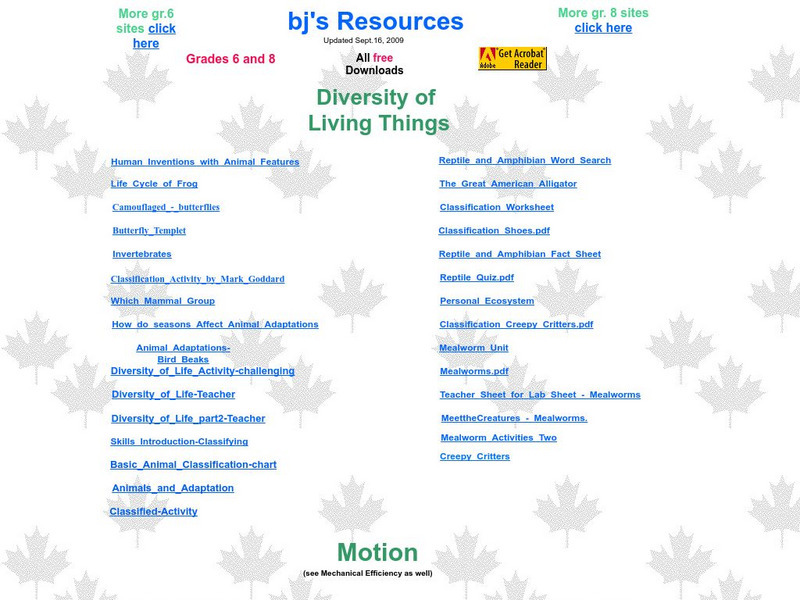Curated OER
LESSON PLANS (print version) pdf What is a Fossil?
Students can better explain how mould and cast fossils occur when they make their own cast fossils using plaster of Paris and objects such as shells, bone or even their own hand or footprint.
Curated OER
PICKING PEANUTS
Learners create sentences, using words printed on pictures of peanuts. They are explained that the peanut is not really a nut, but a legume, related to beans and peas. Students are also told that the first peanuts grew in Brazil. They...
Curated OER
The Lepidoptera Project
Students are introduced to Scientific Inquiry and discover how to design an experiment that answers critical questions using butterflies as the topic. They design experiments that compare the number of species of butterflies in a vacant,...
Curated OER
Awesome Animals
Students collect data from classmates about their favorite animal. They use the ClarisWorks graphing program to enter data, graph results, and interpret data.
Curated OER
Dive and Discover the Ocean
Third graders investigate the three zones of the ocean and the plants and animals that live in each zone. Projects produced are shared with classmates in a share circle where the unique features of the animal and zone selected are...
Curated OER
Primary Producers
Middle schoolers examine the role of carbon in the oceans and how phytoplankton determine the levels present. In groups, they practice measuring primary productivity using two methods. They use the internet to research the role of...
Curated OER
UMNH: The Fremont People
Third graders explore the Fremont people and then make their own Fremont-Style pottery.
Curated OER
the Wonder of Wetlands
Students explore the importance of the wetland ecosystem, its properties and functions, as well as, the many birds, animals, and plant life found there.
Curated OER
Mud in the Water
Students build a soil erosion model to study the importance of soil conservation. They investigate how land forms from both constructive and destructive forces.
Curated OER
Estuarine Habitats
Sixth graders study the important habitats, flora, fauna, and physical factors of coastal habitats. They compare the aquatic habitats to terrestrial habitats by researching and completing tables with the information.
Curated OER
Fresh or Salty?
Students explore water bodies on the planet Earth and their various uses and qualities. They examine several ways that engineers are working to maintain and conserve water sources and think about their role in water conservation....
Curated OER
Who Works in This Forest?
Students examine the variety of jobs that are related to working in the forest. Information on the different jobs is provided in this lesson plan for the teacher to share with the students. The students create a collage using magazines...
Curated OER
Plants and Air Purity
Young scholars explore how green plants help improve air quality. They read an article and discuss the importance of air quality and its effects on the human body. They investigate by connecting hose to the top of a Bell jar and to a...
Curated OER
Biodiversity Bird Hunt
Students examine the influence of biodiversity on human culture through the use of birds. They brainstorm words that come to mind when they think of human cultures. They describe ways that human culture and biodiversity are linked.
Curated OER
Feedback and Flowcharts
Sixth graders explain what a negative feedback system is and they distinguish it from a positive feedback system. They describe examples of how negative feedback is used in both nature and technology. , Students define homeostasis, and...
Curated OER
Virus Tracker
Sixth graders will simulate the spread of a virus such as HIV through a population by "sharing" (but not drinking) the water in a plastic cup with several classmates. Although invisible, the water in a few of the cups will already be...
Curated OER
Truth or Consequences
In this energy conservation worksheet, students answer questions about energy sources and energy use. The worksheet includes both true/false and multiple choice questions. There are 22 questions with answers.
Curated OER
Grow Your Character Bookmarks
Students make bookmarks out of seed paper to study the growth of seeds and complete an activity for the Six Pillars of Character. In this science and character lesson, students describe the stages of growth of plants and determine what...
Curated OER
International Women's Day
Young scholars complete activities to learn about International Women's Day. In this women's importance activity, students discuss the roles women play in young scholars' lives. Students create a collage of special women in their lives...
Curated OER
The Great Hungarian Toxic Disaster
Ninth graders examine the the toxic spill in Hungary. In this Hungarian lesson, 9th graders read an article and answer guided questions. Students write an email to their teacher explaining the causes and effects of the Toxic disaster.
Curated OER
Introduce Vocabulary: a Day at the Apple Orchard
Students explore language arts by reading a story book in class. In this tier two vocabulary lesson, students read the book A Day at the Apple Orchard and identify the use of specific vocabulary words. Students define the selected vocab...
BiologyWise
Biology Wise: Basic Unit of Life: Plant Cell Structure and Functions
Describes the three types of plant cells and their differences, and the structures within a plant cell and their functions.
PBS
Pbs Learning Media: Sock Seeds
In this ZOOMSci experiment, you're invited to walk through a grassy or weedy field in your stocking feet, then plant a sock and see what grows.
My Science Site
Life Systems: Cells, Tissues, Organs
Extensive site for teachers provides some helpful resources that pertain to plant and animal cells. Includes a microscope diagram as well as plant, animal and pond labs. Also contains links to structures and mechanisms, matter and...
























